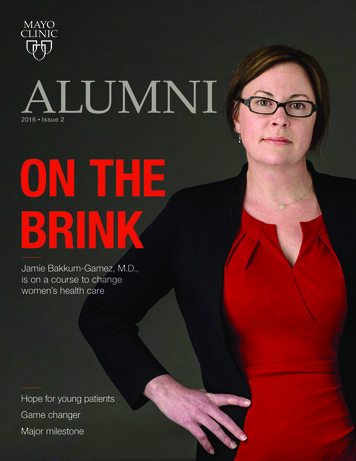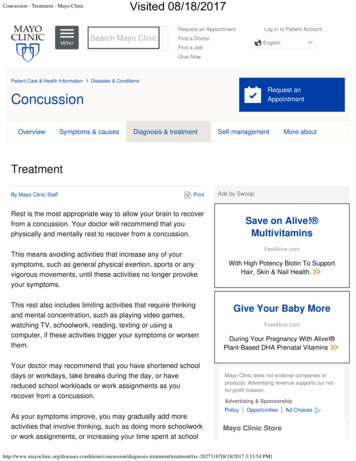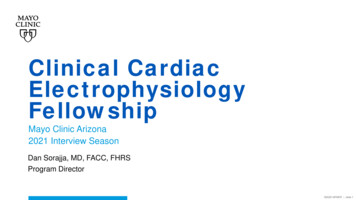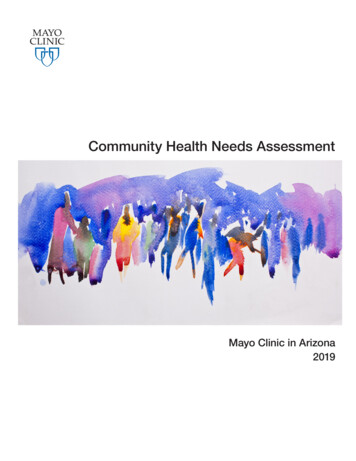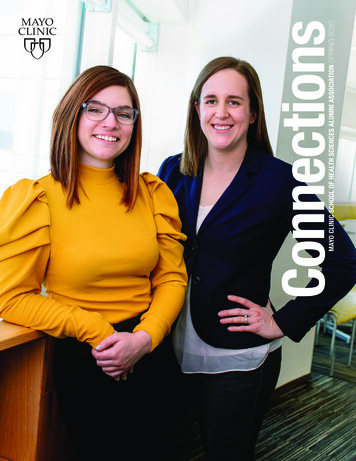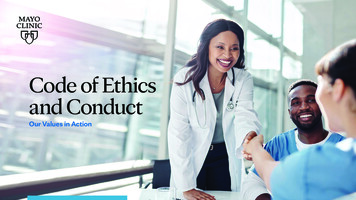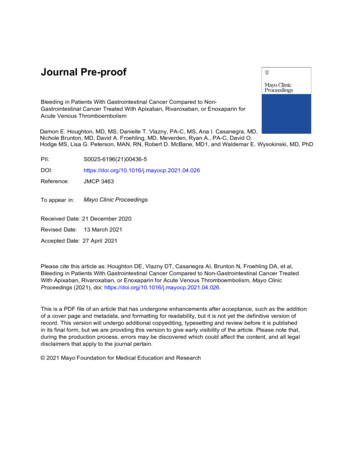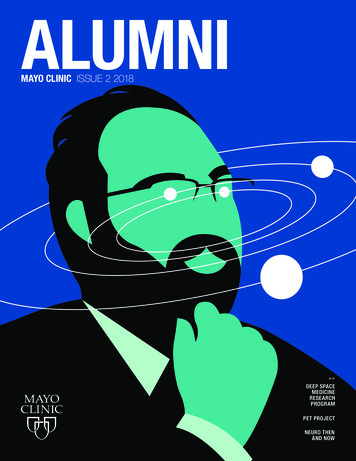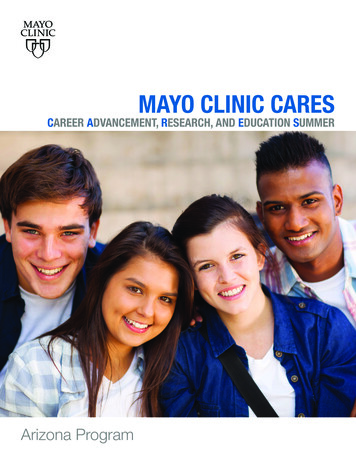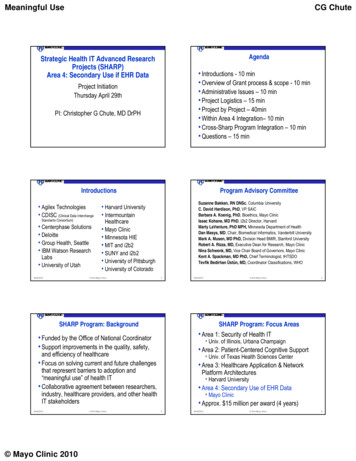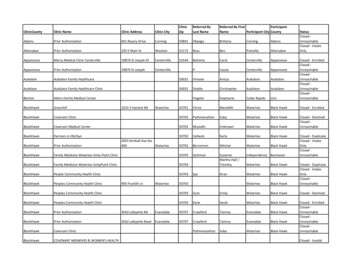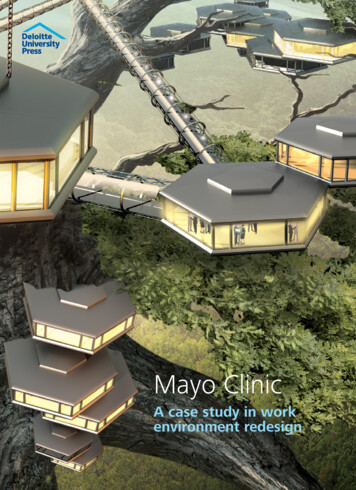
Transcription
Mayo ClinicA case study in workenvironment redesign
A case study in work environment redesignMayo ClinicA case study in work environment redesignCan the way the workplace is constructed—physically, virtually, andmanagerially—affect employee performance? The Deloitte LLP Center for theEdge report Work environment redesign, based on a study of more than 75organizations, argues that the work environment can have a critical impact onemployee productivity, passion, and innovation. The study outlines nine designprinciples that can help employers gain more value from their people.This case study explores ways that Mayo Clinic is applying thesedesign principles to enhance its own corporate environment.Company backgroundand resultsD E S I G NP R I N C I P L E S9its hospitals in Rochester and Phoenix wererecognized by Healthgrades, an online information portal, with a 2013 DistinguishedHospital Award for ClinicalHeads of state and common citiExcellence.2 Mayo constantlyzens alike travel to Mayo Clinic,Pa not-for-profit medicalfinds new ways to improveRNI NGIpractice and mediits performance,CSI PRelevantEcal researchrelying onLDEconnectionsS9group,innovativebecause ofmethodsChallenge-specific“Chance”its highto connectteamingencountersStrengthenqualityits staff andhigh-impactmedicalpatients toReal-timeconnectionstreatthe rightAdaptablefeedback andspacement. Theexperts3reflectionDefineGOALSclinic ngestop ranktion whileSmartRapidings on thehelpingcapture andexperimentationUS Newsthese parshareMutualMeaningful& Worldties learnPownershipchallengesReportquicklyRNI NandimpactGlist offrom oneCII PS“US News bestanother.RankedELEDShospitals” every year foron Fortune maga9the last two decades.1 Two ofzine’s “100 best companies toFigure 1. Work environment design principles used at Mayo Clinic1
Mayo Clinicwork for” list for the last nine years,3 MayoClinic’s collaborative culture translates intosignificant results.Relevant connectionsMayo Clinic’s tradition of teamwork andlearning is supported by a strong technological infrastructure. Through a mobile and tabletapp called AskMayoExpert (see figure 2),4physicians can access content personalized totheir specific situation. In addition to clinicalknowledge, including guidelines and resources,the content includes contact information forthe most relevant specialists and groups withinMayo Clinic. Specialists are assigned based onsubspecialty, and all questions and answers inAskMayoExpert are tagged at multiple levels.Question categories include diagnosis, prevention, treatment, cause, indication for referral,or further follow-up. Answers can be taggedas care process model, FAQ, key fact, qualitymeasure, location, and area of interest (adultversus pediatric, diagnostic versus therapeutic,and so on). Finally, users are able to commentwithin topics. For issues regarding specificpatients, the app provides contact information for a relevant expert.5 Users frequentlydecide to connect with others through thissystem. As Dr. Rick Ishimura, cardiologist andAskMayoExpert project lead, described to StarTribune in late 2010: “Out of the 2,500 physicians we have at Mayo Rochester, about 1,200have started to use it. Many people use it 10 to12 times a day. About two-thirds of them findan answer immediately and about a third willgo on to contact the experts in the area.”62Mayo’s collaborative culture and technology allow doctors to make relevant connections. In Leonard Berry’s The CollaborativeOrganization, Dr. Keith Kelly relates a storyabout a junior surgeon who, shortly afterjoining the staff, was paged by one of his mostexperienced colleagues for advice. Althoughstartled by the request, the junior surgeonrealized that this collaborative problem-solvingwould help the staff provide the most effectiveoperating options for the patient. Thanks toMayo’s unique style of teamwork, the patientrecovered successfully. The junior surgeon realized that even the most senior surgeons neededconnections and assistance from all areas ofthe organization.7Smart capture and shareMayo Clinic encourages home-grown smartcapture and share technologies to enhanceits collaborative culture. For example, MayoClinic’s patient scheduling system, afterinstantly synthesizing patient availability, traveltime, and other important prerequisites totreatment, assigns appropriate physicians andappointments. Once the patient arrives at anappointment, all preceding patient interactions, lab, and exam results are shared with thenext clinician in the sequence. With all of thisdata automatically uploaded and algorithmically processed, the average wait time for anappointment in one department decreasedfrom 45 days to 2 days. Similar efforts remaintop priorities as the organization continues toexpand to new locations.8
A case study in work environment redesignIn addition, automatic archiving of indepth problem-solving is cited as a majorbenefit to staff. For example, if someone atMayo Clinic is looking at different vendors anddeciding which option to select, research andconversations with vendors as well as individual meeting notes and associated outcomescan be made easily accessible through MayoClinic’s social collaboration platform. Withoutsuch a system, the information collected wouldbe as temporary as an employee’s notebook;if a similar question surfaces again, the nextemployee might have to repeat the sameprocess without the pertinent backgroundinformation. Fortunately, Mayo Clinic’s socialcollaboration tool allows for archiving and tagging that reduces these duplicative efforts.Rapid experimentation and realtime feedback and reflectionMayo Clinic’s Center for Innovation is oneof the first and the largest to be integrated intomedical practice. In the center’s outpatient lab,Mayo Clinic hosts outpatient visits in whichpatients and physicians try out new processesand physical layouts, including reconfigured floor plans. Because patients may havetrouble describing specific issues, the simulation is observed by industrial engineers, whocan observe a patient’s subtle reactions andprovide real-time feedback to the Mayo Clinicteam about what went well and what could beimproved. The outpatient lab enables rapidexperimentation that helps new processes anddesigns make their way into the patient experience. The emphasis on speed and innovationhas led to improvements at Mayo Clinic. Forexample, prototyping teams tested the idea ofself-service check-in kiosks by quickly crafting cardboard and paper kiosks. Patientsresponded positively, leading to prototypesthat rapidly improved with each round ofuser feedback.9Real-time feedback is also facilitatedthrough social networks. According to Dr.Ferris Timimi at the Mayo Clinic’s Center forSocial Media, social collaboration softwareFigure 2. AskMayoExpert3
Mayo Clinicmay reflect the most effective tool for realtime engagement at present.10 Questions thatpreviously took hours to answer via emailcan be resolved within minutes by crowdsourced feedback on social collaborationsoftware. Clinicians rely on social networking most when they need to work with otherproject members separated by geography andtime. For example, to integrate their practice, which was spread across multiple floors,Mayo Clinic’s transplant coordination staffimplemented a social collaboration softwaregroup in 2009. Using social collaborationsoftware, the group is able to address realtime practice issues and opportunities and hasbeen able to spread across two separate MayoClinic locations.4Lessons learned Instant access to specialists encouragesfrequent collaboration. Communicating valuable information firstrequires a culture of teamwork that canthen be augmented by technology. By creating an experimentation center andembracing rapid prototyping techniques,companies can obtain valuable feedback onservice or process changes.
A case study in work environment redesignEndnotes1. “Mayo Clinic Rankings,” USNews a/mn/mayo-foundation-661MAYO/rankings, accessed December 2012.2.“Healthgrades Hospital Quality ClinicalExcellence Report 2013,” Healthgrades, 2013,pp. 5-9, ealthgrades-hospitalquality-methodology, accessed January 2013.3. “100 Best companies to work for,”CNNMoney, ies/2012/snapshots/71.html, accessed January 2013.4. iTunes Preview, “AskMayoExpert,” 1135481?mt 8, accessed December 2012.5. Farris Timimi (medical director,Mayo Clinic Center for Social Media),email interview, January 2013.6. Chen May Yee, “Sharing expertise to servepatients,” Star Tribune, January 8, 2011, ?refer y, accessed December 2012.7. Leonard Berry, “The collaborative organization:Leadership lessons from Mayo Clinic,” Organizational Dynamics, June 2004, pp. 228–242.8. Douglas McCarthy, Kimberly Mueller, and Jennifer Wrenn, Mayo Clinic:Multidisciplinary teamwork, physician-ledgovernance, and patient-centered culture, TheCommonwealth Fund, August 2009, http://www.commonwealthfund.org/ 06 McCarthy Mayo case%20study.pdf, accessed December 2012.9. Mayo Clinic, “Center for Innovation,” do/the-center-for-innovation,accessed January 2013; The SPARC innovationprogram at Mayo Clinic, Mayo Clinic, exus.som.yale.edu.design-mayo/files/imce imagepool/Sparc%20Development%20Brochure.pdf, accessed December 2012.10. Timimi interview.About the authorKelly Cheng Deloitte Consulting LLPKelly Cheng is a consultant in Deloitte Consulting LLP’s Strategy & Operations practice. Shefocuses primarily on growth strategy work in the health care, financial services, and technologysectors. Many of her clients look to emerging technologies to drive growth opportunities. Her workat the Center includes conducting primary and secondary research on talent development andhelping to develop the launch strategy for “Pragmatic Pathways,” a framework to help companiesscale change.5
ContactFor more information about this report or about the Center for the Edge, please contact:Blythe AronowitzChief of Staff, Center for the EdgeDeloitte Services LP 1 408 704 2483baronowitz@deloitte.comFollow @DU PressSign up for Deloitte University Press updates at www.dupress.com.About Deloitte University PressDeloitte University Press publishes original articles, reports and periodicals that provide insights for businesses, the public sector andNGOs. Our goal is to draw upon research and experience from throughout our professional services organization, and that of coauthors inacademia and business, to advance the conversation on a broad spectrum of topics of interest to executives and government leaders.Deloitte University Press is an imprint of Deloitte Development LLC.This publication contains general information only, and none of Deloitte Touche Tohmatsu Limited, its member firms, or its and theiraffiliates are, by means of this publication, rendering accounting, business, financial, investment, legal, tax, or other professional adviceor services. This publication is not a substitute for such professional advice or services, nor should it be used as a basis for any decision oraction that may affect your finances or your business. Before making any decision or taking any action that may affect your finances oryour business, you should consult a qualified professional adviser.None of Deloitte Touche Tohmatsu Limited, its member firms, or its and their respective affiliates shall be responsible for any losswhatsoever sustained by any person who relies on this publication.About DeloitteDeloitte refers to one or more of Deloitte Touche Tohmatsu Limited, a UK private company limited by guarantee, and its network ofmember firms, each of which is a legally separate and independent entity. Please see www.deloitte.com/about for a detailed descriptionof the legal structure of Deloitte Touche Tohmatsu Limited and its member firms. Please see www.deloitte.com/us/about for a detaileddescription of the legal structure of Deloitte LLP and its subsidiaries. Certain services may not be available to attest clients under the rulesand regulations of public accounting.Copyright 2013 Deloitte Development LLC. All rights reserved.Member of Deloitte Touche Tohmatsu Limited
Mayo Clinic A case study in work environment redesign Company background and results Heads of state and common citi-zens alike travel to Mayo Clinic, a not-for-profit medical practice and medi-cal research group, because of its high-quality medical treat-ment. The clinic has achieved top rank-ings on the US News & World Report list of "US .
